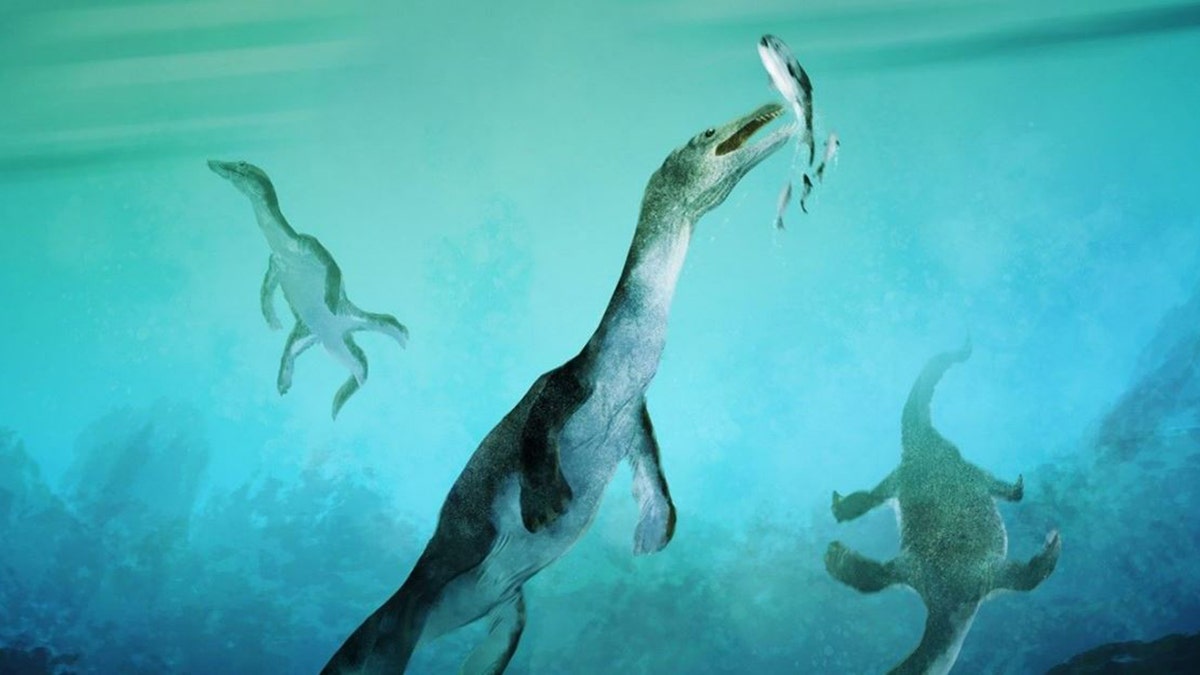'Bonecrushing' crocodile that hunted dinosaurs 230M years ago discovered in Brazil
An ancestor of the crocodile has been discovered in Brazil
A 246 million-year-old reptile fossil discovered by scientists in New Zealand has been identified as the oldest marine reptile fossil found in the Southern Hemisphere, according to a Swedish museum.
The vertebra of a nothosaur, a type of Sauropterygian, an extinct aquatic reptile that lived during the Triassic period at the dawn of the dinosaurs, was first excavated from a boulder in 1978, but wasn't identified until recently, according to a release from Uppsala University’s Museum of Evolution in Sweden.
Almost 252 million years ago, reptiles invaded the seas following a catastrophic mass extinction that led to the age of the dinosaurs.
"Evidence for this evolutionary milestone has only been discovered in a few places around the world: on the Arctic island of Spitsbergen, northwestern North America and southwestern China," the university said.
LOKICERATOPS, A ’REMARKABLE' NEW DINOSAUR SPECIES HAS BEEN FOUND IN MONTANA, RESEARCHERS SAY

An artist's rendering of a nothosaur swimming near what is now New Zealand 246 million years ago. (Stavros Kundromichalis/Uppsala University Museum of Evolution)
The vertebra was excavated from a boulder in a stream bed at the foot of Mount Harper on the South Island of New Zealand, the release said, adding "this discovery has shed new light on the previously unknown record of early sea reptiles from the Southern Hemisphere."
Nothosaurs were predecessors of Plesiosaurs, and could grow to be nearly 23 feet in length. Plesiosaurs first emerged around 203 million years ago.

Giant Pliosaur fossil at the Natural History Museum in London. Nothosaurs were predecessors of Plesiosaurs. (Mike Kemp/In Pictures via Getty Images)
Nothosaurs swam with four limbs and had conical teeth for catching fish and squid.
"The New Zealand nothosaur was discovered during a geological survey in 1978, but its importance was not fully recognised until palaeontologists from Sweden, Norway, New Zealand, Australia and East Timor joined their expertise to examine and analyse the vertebra and other associated fossils," the university said.
LONG-LOST ASSYRIAN CAMP RECENTLY FOUND SUPPORTS BIBLICAL ACCOUNT, EXPERT SAYS
Uppsala University paleontologist Dr. Benjamin Kear, who is the lead author of the study, said in a statement the nothosaur fossil is more than 40 million years older than any previously discovered sauropterygian fossil in the Southern Hemisphere.
"We show that these ancient sea reptiles lived in a shallow coastal environment teeming with marine creatures within what was then the southern polar circle," he said.

The skeleton of a Tyrannosaurus rex is seen in the Dinosaur Gallery of the Royal Belgium Institute of Natural Sciences on April 7, 2023, in Brussels. (Thierry Monasse/Getty Images)
He said the fossil has completely upended scientists' understanding of how nothosaurs swam from one end of the Earth to the other.
"Using a time-calibrated evolutionary model of sauropterygian global distributions, we show that nothosaurs originated near the equator, then rapidly spread both northwards and southwards at the same time as complex marine ecosystems became re-established after the cataclysmic mass extinction that marked the beginning of the Age of Dinosaurs" Kear said.
CLICK HERE TO GET THE FOX NEWS APP
He added that "extreme global warming" during the dawn of the age of the dinosaurs allowed "these marine reptiles to thrive at the South Pole. This also suggests that the ancient polar regions were a likely route for their earliest global migrations, much like the epic trans-oceanic journeys undertaken by whales today. Undoubtedly, there are more fossil remains of long-extinct sea monsters waiting to be discovered in New Zealand and elsewhere in the Southern Hemisphere."






















